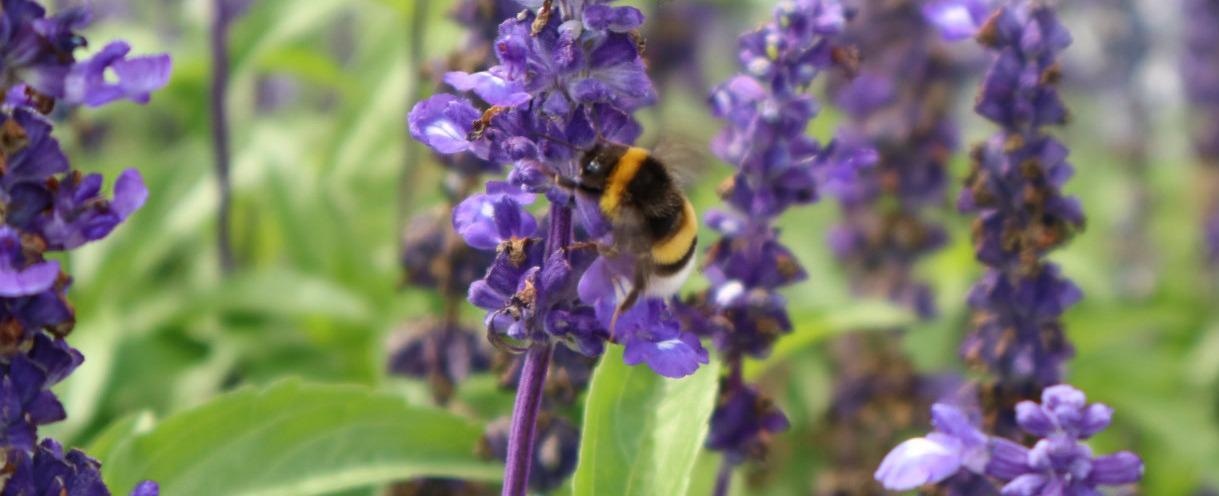Reviewed by Alex SmithMay 9 2022
A huge decline in insect diversity has been experienced in Bavaria. Land use is considered a significant factor, but the effect of climate change is still unidentified. A study performed by the University of Würzburg has currently examined how both factors interact.
 A super-generalist bumble bee (Bombus terrestris) visiting salvia flowers (Salvia farinacea) in an urban area. Image Credit: Cristina Ganuza.
A super-generalist bumble bee (Bombus terrestris) visiting salvia flowers (Salvia farinacea) in an urban area. Image Credit: Cristina Ganuza.
Around 75% of the food crops and over 80% of wild plants are in need of pollination by insects. The estimated value of crop pollination alone is calculated to be 577 billion US dollars annually throughout the world.
Bees are known to be the popular pollinators, but these are in no way the only insects that offer this service to humans and nature. Wasps, flies, beetles, butterflies, and moths also play significant roles.
In the past few years, numerous studies have determined a considerable fall in insect populations — also in Germany. Until now, the concentration has been on the loss of appropriate habitats for insects; for instance, the transformation of natural areas into urban or agricultural regions.
However, the study questions the impacts of land use jointly with warmer and dryer climates for pollinating insects as well as what can be done to reduce possible negative effects. The new study by the Julius-Maximilians-University (JMU) Würzburg examined all of these issues.
The Key Findings
The research group and collaborators from JMU disclose initially how climate and land use help collectively shape the diversity of pollinating insects at local and landscape scales throughout Bavaria.
Depending on over 3200 identified pollinator species gathered from 179 locations in grassland, forest, arable and urban habitats, they determine the homogenization of pollinator communities in warmer climates. This indicates a complete loss of pollinator diversity under future climates.
Individual taxa like bees, butterflies, beetles, flies, and moths displayed various responses to warmer and dryer climates. However, the general pattern denotes that the landscapes with greater proportions of forest retain the majority of the diverse pollinator communities.
One key finding therefore is that forest in the landscape can cushion the effects of climate warming to a certain extent.
Cristina Ganuza, Ph.D. Student and Study Lead Author, Department of Animal Ecology and Tropical Biology, Julius-Maximilians-Universität Würzburg
Cristina Ganuza is a Ph.D. student in the group of Professor Ingolf Steffan-Dewenter.
Steffan-Dewenter stated, “The study underpins that in addition to the importance of floral resources and the negative effects of land use intensification, climatic conditions play an increasingly important role for the maintenance of pollinator diversity.”
“For example, the combination of high temperatures and low precipitation negatively affected total pollinator diversity, while bee richness in urban areas was negatively affected by higher mean temperatures,” added Steffan-Dewenter.
The Relevance for Humans and Nature
High pollinator diversity is needed for high pollinator performance.
However, the combination of ongoing climate change and current land use will only allow certain pollinator species to survive in different habitat types.
Cristina Ganuza, Ph.D. Student and Study Lead Author, Department of Animal Ecology and Tropical Biology, Julius-Maximilians-Universität Würzburg
Ganuza added, “We conclude that a large proportion of forested land in the landscape could serve as refuge for insects from climate warming. This is likely because forests and forest edges provide largely natural conditions which buffer extreme heat and drought compared to more human-influenced habitats.”
One more suggestion from the scientists would be to reduce the air temperature in cities, for instance via greening.
This could lead to more bee species being able to live in urban areas.
Cristina Ganuza, Ph.D. Student and Study Lead Author, Department of Animal Ecology and Tropical Biology, Julius-Maximilians-Universität Würzburg
Insects prefer it diverse. Also, flowering plants that are as diverse as possible are crucial for the small animals in all regions.
The study was conducted in collaboration with the University of Bayreuth, the Technical University of Munich, and the University of Applied Sciences Weihenstephan-Triesdorf.
The Bavarian State Ministry of Science and the Arts funded it as part of the Bavarian Climate Research Network’s research cluster “LandKlif—Impacts of climate change on biodiversity and ecosystem services in semi-natural, agricultural, and urban landscapes, and climate change management strategies.”
Journal Reference:
Ganuza, C., et al. (2022) Interactive effects of climate and land use on pollinator diversity differ among taxa and scales. Science Advances. doi.org/10.1126/sciadv.abm9359.